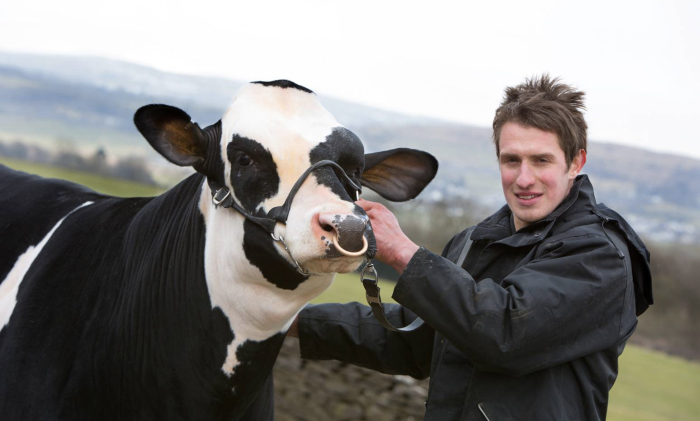
The use of Estimated Breeding Values (EBVs) when bull buying was one of the topics discussed at the recent Clyde monitor farm meeting.
The monitor farmer is Andrew Baillie of Carstairs Mains in south Lanarkshire. His 650 acre (263 ha), mixed unit is one of the network of Quality Meat Scotland (QMS) monitor farms throughout Scotland.
In addition to a spring calving commercial suckler herd, Mr Baillie also runs two small pedigree enterprises of British Blue and Limousin, both under the “Carstairs” prefix.
Increasing numbers of pedigree cattle breeders are recording their cattle, providing potential purchasers with estimates of an animal’s genetic merit for particular traits, including calving ease, growth rate, fat depth, milk and retail meat yield.
At the monitor farm meeting, SAC Consulting (a division of SRUC, Scotlands Rural College) Beef Specialist Gavin Hill led the discussion on how commercial cattle breeders can use EBV figures to help make informed bull purchases.
“Remember EBVs are just another tool to assist in bull selection”, said Mr Hill.
“The word “Estimated” is important – the figures have been calculated from the data of all recorded relatives to the bull himself, to give an Estimated Breeding Value of the bull’s genetic merit, half of which will be passed on to his progeny.
Farmers should note the accuracy figures for each trait and be aware of low accuracy percentages: the more information from recorded relatives, the higher the accuracy percentage. EBV figures for individual traits may change as more related animals’ figures are recorded, so Mr Hill suggested that farmers check their bull’s updated figures with the relevant Breed Society, from time to time. It is also worth remembering that each breed’s EBVs are just for comparison of individual animals within that specific breed and cannot be compared across breeds.
Most Beef Breed Societies present EBVs in an easily understood table. The EBV chart to the right is for monitor farmer Andrew Baillie’s British Blue stock bull – Netherhall Extra Special. Shown by Mr Baillie at last year’s Royal Highland Show, this bull won the Senior Bull class.The general rule of thumb is that figures to the Right of the central, Breed Average line, are good. Figures to the Left - not good.
“Irrespective of EBV figures, it’s crucial that you look closely at any bulls you’re considering, before purchasing” added Mr Hill. “Ensure you see the bulls you’re considering walking, when you can check legs, locomotion, conformation, structure and everything else. If possible, see them being washed, when their hair is flat!
“Some buyers go through the catalogue before a sale, selecting the bulls with the EBVs they want, and then check them over physically in the mart. Others pick out the bulls they like the look of at the sale, and then check the EBVs.”
Different breeding enterprises will seek different traits, which will determine which EBV figures need to be prioritised. For calves destined for store cattle sales high EBVs for 200 and 400 Day Weights should be considered.
For progeny finished on farm high EBVs for 600 Day Weight, Muscle Depth, Retail Yield, and Fat Depth should be sourced if possible. “Be aware of what your market requires,” warned Mr Hill. “Some processors are specifying a maximum carcase weight of around 420/430 kgs, so to avoid penalties, you will need your cattle to be properly finished and hung up within any specified weight limit.”
For heifers to be retained or sold for breeding, the Calving Ease for Daughters, high 400 Day Weights (especially if aiming to calve at two years), Milk and Scrotal Circumference (influences onset of puberty in daughters) should be considered.
Milk figures should be reviewed with caution, as if the females in the herd are already milky, aiming for more milk runs the risk of breeding females which will demand a lot of feed just to fuel their high milk production.
Farmers looking to breed hardy females, capable of out-wintering, should consider the Fat Depth EBV as cows with good fat cover have better protection against the rain and cold than leaner ones.
Mr Hill explained that fat level scores have recently been reviewed - “Issues arose in that the genetic recording system used to reward for leanness. Industry reported that an increasing proportion ofcarcases were too lean and not finished with adequate fat cover. Too often lean sires were being mated to continental type cows which had little fat cover. Consequently the Charolais and Limousin Breed Societies have reversed their index for Fat and now reward higher levels.”
When purchasing a bull for use over heifers the Calving Ease Direct figure is particularly relevant. “Also worth noting,” added Mr Hill, “is the Gestation Length EBV. A calf grows significantly in the days immediately prior to calving, hence a longer gestation can increase the risk of calving difficulties.
Calving ease is not all about the bull! How the cow will calve depends on 75% management and 25% genetics. The management of the in-calf females is really important, and coming up to calving, farmers should make sure that the cows or heifers are not carrying too much condition.
With getting females in calf being the bull’s basic must do job – Mr Hill emphasised the importance of scrotal circumference. “The size of the scrotum is a fertility measurement and bigger really is better! Remember the bull needs to be capable of getting all the females he’s put to in calf as quickly as possible, so sperm quantity as well as quality is required.
“Also, there’s a co-relation between scrotal circumference and the onset of puberty of daughters, so for breeding heifers intended to calve at two years old, this is worth consideration.”
